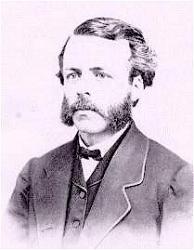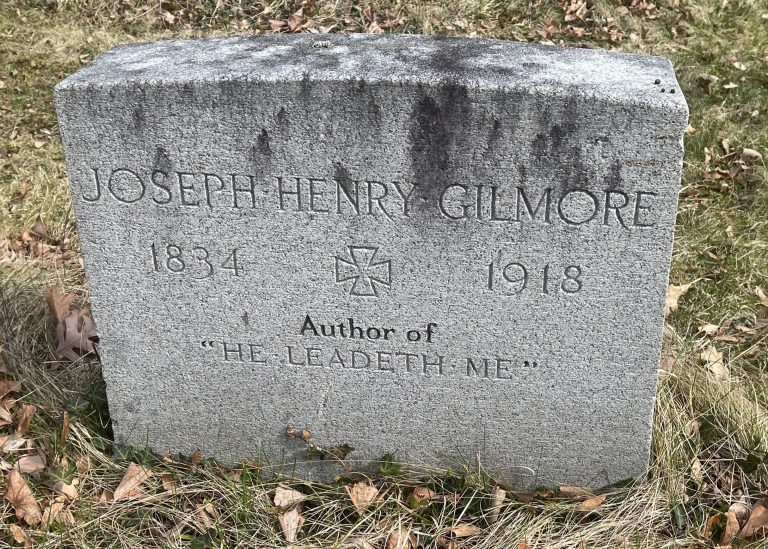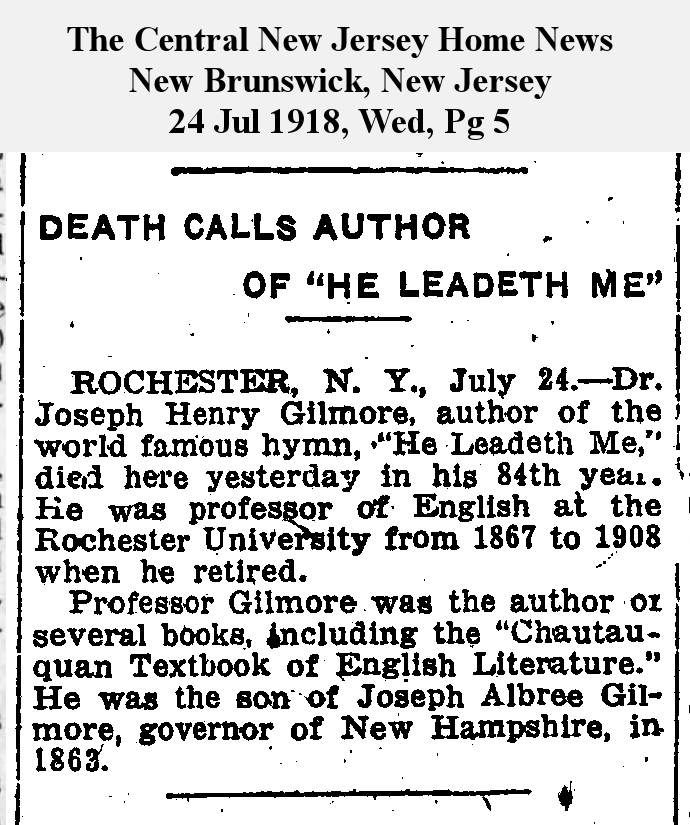Hymn History: He Leadeth Me & Author: Joseph H. Gilmore
“I set out to give the people an exposition of the 23rd Psalm, which I had given before on three or four occasions, but this time I did not get further than the words ‘He Leadeth Me.’ Psalm 23:2, ‘he leadeth me beside the still waters,’ became the theme of the song”
(Joseph H. Gilmore)
The Origin of the Hymn “He Leadeth Me”
Few hymns have expressed trust in God’s guidance with such enduring simplicity and power as “He Leadeth Me.” For more than a century and a half, congregations have sung its reassuring words, finding comfort in the reminder that the Lord directs His children through every circumstance of life. The story of this hymn’s origin takes us to a moment of pastoral reflection during a difficult season, when a young minister turned his thoughts toward God’s faithful leading.
Joseph Gilmore: The Author
The text of “He Leadeth Me” was written by Joseph Henry Gilmore (1834–1918), a Baptist minister and later a professor of Hebrew at Rochester Theological Seminary. Born in Boston, Gilmore was the son of a governor of New Hampshire and received an excellent education. He studied at Brown University and Newton Theological Institution before entering pastoral ministry.
Though he would go on to have a fruitful career as both pastor and scholar, Gilmore is remembered today almost entirely for the hymn he penned in his twenties. Remarkably, he did not originally intend for his words to become a hymn at all—they were first spoken in an informal Bible study.
The Setting: Philadelphia, 1862
The hymn was born during the turbulence of the American Civil War. In March 1862, while serving a brief supply pastorate at the First Baptist Church of Philadelphia, Gilmore was invited to preach one Sunday. His text was Psalm 23, the beloved shepherd psalm that declares, “He leadeth me beside the still waters.”
After the service, Gilmore and a small group gathered in the home of Deacon Watson, a member of the church, to continue discussing the Scripture. As they reflected on the theme of God’s guidance, Gilmore found himself deeply moved by the simple phrase, “He leadeth me.” In that time of national uncertainty and personal reflection, those words seemed to capture the essence of the believer’s hope.
That evening, in the quiet of the deacon’s parlor, Gilmore took up a pencil and quickly wrote the lines of what would become the hymn “He Leadeth Me.” He later recalled, “I handed the verses to my wife, and thought no more about them.”
From Poem to Hymn
Unbeknownst to Gilmore, his wife tucked the verses away and later sent them to the Watchman and Reflector, a Baptist periodical. There they were published in 1862. Around the same time, the words caught the attention of William Batchelder Bradbury (1816–1868), a well-known composer of gospel songs and Sunday school hymns.
Bradbury was deeply moved by Gilmore’s text and composed a tune to match it. He also added the refrain that has become so familiar:
His faithful follower I would be,
For by His hand He leadeth me.
This addition reinforced the theme of trust and discipleship, giving the hymn a memorable structure that made it easy for congregations to sing. Bradbury’s tune, gentle yet steady, perfectly matched the spirit of the words.
Reception and Spread
Once published with Bradbury’s music, “He Leadeth Me” quickly became popular in American churches. Its themes of trust in God’s providence resonated especially during the Civil War era, when uncertainty and loss were widespread. Over the years, it has appeared in countless hymnals and been translated into multiple languages.
The hymn’s popularity endured long after the war, becoming a staple in both Protestant worship and personal devotion. Gilmore himself was surprised by its lasting impact. Later in life, he reflected: “I did not realize at the time how deeply it touched the chord of human need, nor dream that it would become a living song of faith for the people of God.”
Theological Emphasis
At its heart, “He Leadeth Me” is a hymn of trust. It does not describe dramatic experiences or mountaintop visions but the quiet, steady assurance of God’s guidance. Whether in “scenes of deepest gloom” or “by waters calm,” the believer can rest in the conviction that God leads through every circumstance.
The refrain emphasizes the believer’s response: to be a “faithful follower.” The hymn thus balances divine sovereignty with human responsibility—God leads, and His people willingly follow. It echoes not only Psalm 23 but also the broader biblical theme of God as Shepherd and Guide.
Legacy
Joseph Gilmore went on to serve as pastor of several Baptist churches and later as a seminary professor. Yet, despite his many contributions in ministry and education, his name is chiefly remembered for this hymn. William Bradbury, who also gave the church beloved tunes like those for “Jesus Loves Me” and “Sweet Hour of Prayer,” ensured that Gilmore’s words would find a lasting place in Christian song.
More than 160 years later, “He Leadeth Me” continues to be sung around the world. Its gentle assurance offers comfort in times of fear, direction in times of uncertainty, and hope in times of sorrow. It reminds believers that the same God who led His people in the past still leads His children today—by His hand, step by step.
Conclusion
The origin of “He Leadeth Me” is a testimony to how God can use the simplest reflections to inspire enduring faith. What began as an impromptu meditation on Psalm 23 in a Philadelphia parlor became one of the church’s most beloved hymns. Through Joseph Gilmore’s words and William Bradbury’s music, generations of believers have been encouraged to trust in God’s unfailing guidance.
Even in a world marked by uncertainty, the hymn continues to echo the promise of the Shepherd: “He leadeth me beside the still waters … He restoreth my soul.”
Related
Sorry, no records were found. Please adjust your search criteria and try again.
Sorry, unable to load the Maps API.


